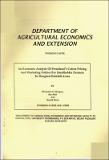| dc.contributor.author | Shongwe, Phumulela S. | |
| dc.contributor.author | Mano, Reneth | |
| dc.contributor.author | Muir, Kay | |
| dc.coverage.spatial | Swaziland | en |
| dc.date.accessioned | 2015-08-14T13:43:38Z | |
| dc.date.available | 2015-08-14T13:43:38Z | |
| dc.date.issued | 2000-03 | |
| dc.identifier.citation | Shongwe, P., Muir, K. and Mano, R. (2000) An Economic Analysis of Swaziland’s Cotton Pricing and Marketing Policies for Smallholder Farmers in Marginal Rainfall Areas. AEE Working Paper no. 5/2000. UZ, Mt. Pleasant, Harare: DAEE. | en |
| dc.identifier.uri | https://opendocs.ids.ac.uk/opendocs/handle/20.500.12413/6754 | |
| dc.description | An AEE Working Paper on cotton pricing and marketing for small holder farmers in Swaziland low rainfall areas. | en |
| dc.description.abstract | Cotton is the main source of income for rural households in the smallholder-farming sector and provides employment at rural and national level. Despite the vital role played by cotton, production has declined since 1991. The main objective of the study was to identify the country's competitiveness and comparative advantage in cotton production. In addition the study highlights the factors affecting cotton profitability.
The world market was used to assess Swaziland's comparative advantage in producing cotton because of the on-going reforms in the SADC market. Smallholder farmers in kaKhuphuka have a DRC of 1.2 indicating that they would not be efficient competing on the world market. However, access to the Republic of South Africa results in higher prices and a DRC of 0.98, indicating efficiency in cotton production. There was a marked difference in the productivity of low and high performing smallholders, high performers achieved DRCs of 0.98 at world market prices and 0.87 at RSA prices.
Factors such as fertiliser application rate, area under cotton production, level of education, farming experience and pesticide use were important than credit in affecting yield, although credit was also significant at p=0.05. Low performing credit farmers are making negative profits and apparent irrational producing cotton. The study revealed that, if low performing farmers increase yields by 13% in order that they will be profitable at the rural daily labour wage rate. Alternatively low-performers are considered rational to continue producing cotton if one assumes that the opportunity cost of labour is 44% lower at E 4.50 per man day. Improvement of technology through research and extension is critical in increasing farmers'yields and subsequently both profits and Swaziland's competitiveness in cotton production. | en |
| dc.language.iso | en | en |
| dc.publisher | Department Of Agricultural Economics and Extension (DAEE) (University of Zimbabwe) (UZ) | en |
| dc.relation.ispartofseries | Working Paper AEE;5/2000 | |
| dc.rights.uri | http://creativecommons.org/licenses/by-nc-nd/3.0/ | en |
| dc.subject | Agriculture | en |
| dc.subject | Rural Development | en |
| dc.subject | Trade | en |
| dc.title | An Economic Analysis of Swaziland’s Cotton Pricing and Marketing Policies for Smallholder Farmers in Marginal Rainfall Areas | en |
| dc.type | Series paper (non-IDS) | en |
| dc.rights.holder | University of Zimbabwe (UZ) | en |


